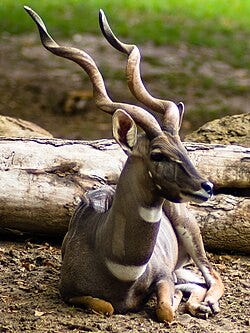Say hello to Jager, a lesser kudu antelope calf at the Fort Worth Zoo. Those eyelashes are fabulous! Jager was born on March 23 to parents Martini (!!) and Lemon Drop, the zoo acknowledging they are going with a theme on the naming conventions. As per their social media post, keepers say Jager is “sassy and sleepy” (me too!), sneaking naps in behind his bowl of hay. He is not quite ready to be presented to the public yet and is hanging out behind the scenes with mom Lemon and “auntie” Tangerine. In the wild, a female lesser kudu about to give birth will isolate herself and remain alone some days afterwards, so this period of separation from the majority of the herd is not uncommon behavior. But when they are ready, this smaller group will likely rejoin their zoo comrades, as lesser kudus—particularly females and their young—are gregarious in nature.
Kudus are well-recognized for the magnificent long, twisting horns of mature males. Both lesser and greater kudus have reddish brown to blue-gray hides with a white stripe that runs down the back. But while greater kudus have 6 to 10 vertical stripes descending from their back down their sides, the lesser kudu has 11 to 15 stripes. However, it’s not the number of stripes that make the name: the greater kudu is one of the largest antelopes, with bulls weighing about 570 pounds, while lesser kudus are much smaller, weighing in at about 230 pounds.
Lesser kudus inhabit dry bushland regions of northeastern Africa (Ethiopia, Kenya, Somalia, South Sudan, Tanzania and Uganda). They prefer shaded areas with short grasses, but can also be found in woodlands and primarily lower-elevation hilly areas, although a small number have been observed at heights near Mount Kilimanjaro. The kudu relies on its excellent camouflage, keen hearing, and ability to stand completely motionless to avoid predators, grazing during the night up to dawn and sheltering in thickets after sunrise. Members of the Bovadae family, they feed on foliage, herbs, flowers and fruits as available, and a small proportion of grasses, particularly during the wet season. They have low water requirements which allow them to thrive in arid environments: during the dry season they derive the majority of their hydration from succulent plants.
Thanks to their camouflage ability and their natural shyness, lesser kudus have mostly managed to avoid poaching risks. However, they are highly susceptible to a viral infection called “rinderpest,” which has greatly decreased populations in some regions. Fortunately, scientists have deemed the virus completely eradicated in 2011 and expect a population rebound for decimated herds. Lesser kudus also suffer from loss of habitat, overgrazing and other survival threats. They are currently listed as a “near threatened” species, with about 118,000 lesser kudu remaining in the wild.
The lifespan of a lesser kudu is 10-15 years in the wild, and about 20 in captivity. Here’s hoping for many birthdays for young Jager as he grows his own maganicifent set of headgear.
Your source video is here:







Handsome little guy. Like those two white stripes radiating from his eyes towards his nose. Classy. Wouldn't mind having a (small) herd of those in my (large) backyard.
Those lashes! Kudu makes my heart beat a bit faster.